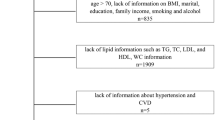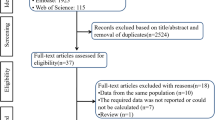Abstract
Type 2 diabetes mellitus (DM) is a growing global epidemic, especially among aboriginal Taiwanese. This study aimed to identify the relationship between erectile dysfunction (ED), markers of endothelial function, serum testosterone level and type 2 DM in aboriginal Taiwanese. Data were obtained from a baseline survey of 240 aboriginal adults. Their demographic data, presence of type 2 DM, markers of endothelial function, serum testosterone and ED status were assessed. The mean age of the samples was 51.62±7.76 years. The International Index of Erectile Function-5 total score had a mean of 21.99±2.34 and a median of 23; 134 participants had ED (55.8%). The results showed an increased risk of ED for participants with type 2 DM and lower serum testosterone level. Among the predictors of ED, type 2 DM, lower serum free testosterone and high-sensitivity C-reactive protein were significantly independent factors. Interleukin-6 had a negative relationship with ED. The study results suggest there is a strong association between type 2 DM and erectile function among aboriginal Taiwanese that is similar to the general population. This study also supports the idea that type 2 DM, markers of endothelial function and serum testosterone may provide warning signs of ED and, at the same time, an opportunity for early intervention for aboriginal adult male.
This is a preview of subscription content, access via your institution
Access options
Subscribe to this journal
Receive 8 print issues and online access
$259.00 per year
only $32.38 per issue
Buy this article
- Purchase on Springer Link
- Instant access to full article PDF
Prices may be subject to local taxes which are calculated during checkout
Similar content being viewed by others
References
NIH Consensus Conference. Impotence. NIH Consensus development panel on impotence. JAMA 1993; 270: 83–90.
Chew KK, Earle CM, Stuckey BGA, Jamrozik KD, Keogh EJ . Erectile dysfunction in general medicine practice: prevalence and clinical correlates. Int J Impot Res 2000; 12: 41–45.
Fung MM, Bettencourt R, Barrett-Connor E . Heart disease risk factors predict erectile dysfunction 25 years later: the Rancho Bernardo Study. J Am Coll Cardiol 2004; 43: 1405–1411.
Vlachopoulos C, Rokkas K, Ioakeimidis N, Aggeli C, Michaelides A, Roussakis G et al. Prevalence of asymptomatic coronary artery disease in men with vasculogenic erectile dysfunction: a prospective angiographic study. Eur Urol 2005; 48: 996–1003.
International Diabetes Federation Diabetes Atlas Unwin N, Whiting D, Gan D, Jacqmain O, Ghyoot G (eds) IDF Diabetes Atlas 4th edn International Diabetes Federation: Belgium, 2009 pp 11–13.
Schalkwijk CG, Stehouwer CD . Vascular complication in diabetes mellitus: the role of endothelial dysfunction. Clin Sci (Lond) 2005; 109: 143–159.
Selvin E, Burnett AL, Platz EA . Prevalence and risk factors for erectile dysfunction in the U.S. Am J Med 2007; 120: 151–157.
Rock M . Sweet blood and social suffering: rethinking cause-effect relationships in diabetes, distress, and duress. Med Anthropol 2003; 22: 131–174.
Young TK, Reading J, Elias B, O'Neil JD . Type 2 diabetes mellitus in Canada’s First Nations: status of an epidemic in progress. Can Med Assoc J 2000; 163: 561–566.
Hall PF . Ironies most bittersweet. CMAJ 1999; 160: 169.
Chu NF . Prevalence of obesity in Taiwan. Obes Rev 2005; 6: 271–274.
Spector IP, Carey MP, Steinberg L . The Sexual Desire Inventory: development, factor structure, and evidence of reliability. J Sex Marital Ther 1996; 22: 175–190.
Lee HH, Chu YH, Ruan FF, Tzeng DS, Lung FW . Confirmatory factor analysis of the sexual desire inventory in patients with schizophrenia. Taiwan J Psychiatry 2007; 21: 176–184.
Rosen R, Cappelleri J, Smith M, Lipsky J, Pena B . Development and evaluation of an abridged, 5-item version of the International Index of Erectile Function (IIEF-5) as a diagnostic tool for erectile dysfunction. Int J Impot Res 1999; 11: 319–326.
Chandel A, Dhindsa S, Topiwala S, Chaudhuri A, Dandona P . Testosterone concentration in young patients with diabetes. Diabetes Care 2008; 31: 2013–2017.
Whicher JT, Ritchie RF, Johnson AM, Baudner S, Bienvenu J, Blirup-Jensen S et al. New international reference preparation for proteins in human serum (RPPHS). Clin Chem 1994; 40: 934–938.
WHO. Definition and diagnosis of diabetes mellitus and intermediate hyperglycemia (pdf). World Health Organization www.who.int2006, http://whqlibdoc.who.int/publications/2006/9241594934_eng.pdf. Retrieved 10 October 2011.
Jackson G, Rosen RC, Kloner RA, Kostis JB . The second Princeton consensus on sexual dysfunction and cardiac risk: new guidelines for sexual medicine. J Sex Med 2006; 3: 28–36.
Selvin E, Burnett AL, Platz EA . Prevalence and risk factors for erectile dysfunction in the US. Am J Med 2007; 120: 151–157.
Chen KK, Chiang HS, Jiann BP, Lin JS-N, Liu WJ, Wu CJ et al. Prevalence of erectile dysfunction and impacts on sexual activity and self-reported intercourse satisfaction in men older than 40 years in Taiwan. Int J Impot Res 2004; 16: 249–255.
Meena BL, Kochar DK, Agarwal TD, Choudhary R, Kochar A . Association between erectile dysfunction and cardiovascular risk in individuals with type-2 diabetes without overt cardiovascular disease. Int J Diabetes Dev Ctries 2009; 29: 150–154.
Ledda A . Diabetes hypertension and erectile dysfunction. Curr Med Res Opin 2000; 16: S17–S20.
Romeo JH, Seffel AD, Madhum ZT, Aron DC . Sexual function in men with diabetes type 2 association with glycemic control. J Urol 2000; 163: 788–791.
Saenz T . Pathophysiology of erectile dysfunction. J Sex Med 2005; 2: 26–39.
Brownlee M . Biochemistry and molecular cell biology of diabetic complications. Nature 2001; 414: 813–820.
Demir T . Prevalence of erectile dysfunction in patients with metabolic syndrome. Int J Urol 2006; 13: 385–388.
Costa C, Virag R . The endothelial-erectile dysfunction connection: an essential update. J Sex Med 2009; 6: 2390–2404.
Montorsi F, Briganti A, Salonia A, Rotatori F, Veglia F, Briganti A et al. Erectile dysfunction prevalence, time of onset and association with risk factors in 300 consecutive patients with acute chest pain and angiographically documented coronary artery disease. Eur Urol 2003; 44: 360–365.
Chai SJ, Barrett-Connor E, Gamst A . Small-vessel lower extremity arterial disease and erectile dysfunction: the Rancho Bernardo study. Atherosclerosis 2009; 203: 620–625.
Bener A, Al-Hamaq AOAA, Kamran S, Al-Ansari A . Prevalence of erectile dysfunction in male stroke patients, and associated co-morbidities and risk factors. Int Urol Nephrol 2008; 40: 701–708.
Chao JK, Wang TIS, Ma MC, Kuo WH, Liu JH, Chen YP et al. A survey of obesity and erectile dysfunction of men conscripted into the military in Taiwan. J Sex Med 2011; 8: 1156–1163.
Chubb SA, Hyde Z, Almeida OP, Shegem NS, Ajlouni KM . Lower sex hormone-binding globulin is more strongly associated with metabolic syndrome than lower total testosterone in older men: the Health in Men Study. Eur J Endocrinol 2008; 158: 785–792.
Ridker PM . Clinical application of C-reactive protein for cardiovascular disease detection and prevention. Circulation 2003; 107: 363–369.
Kushner I . The phenomenon of the acute phase response. Ann NY Acad Sci 1982; 389: 39–48.
Zacho J, Tybjaerg-Hansen A, Jensen JS, Grande P, Sillesen H, Nordestgaard BG . Genetically elevated C-reactive protein and ischemic vascular disease. N Engl J Med 2008; 359: 1897–1908.
Esposito K, Marfella K, Giugliano F, D’armiento M, Martedì E, Giugliano D, Feola G . High proportions of erectile dysfunction in men with the metabolic syndrome. Diabetes Care 2005; 28: 1201–1203.
Montorsi P, Ravagnani PM, Galli S, Rotatori F, Veglia F, Briganti A, Salonia A, Deho F, Rigatti P, Montorsi F, Fiorentini C . Association between erectile dysfunction and coronary artery disease. Role of coronary clinical presentation and extent of coronary vessels involvement: the COBRA trial. Eur Heart J 2006; 27: 2632–2639.
Kratzik CW, Schatzl G, Lunglmayr G, Rücklinger E, Huber J . The impact of age, body mass index and testosterone on erectile dysfunction. J Urol 2005; 174: 240–243.
Kapoor D, Clarke S, Channer KS, Rucklinger E, Huber J . Erectile dysfunction is associated with low bioactive testosterone levels and visceral adiposity in men with type 2 diabetes. Int J Androl 2007; 30: 500–507.
Lu CC, Jiann BP, Sun CC, Lam HC, Chu CH, Lee JK . Association of glycemic control with risk of erectile dysfunction in men with type 2 diabetes. J Sex Med 2009; 6: 1719–1728.
Jackson G . Prevention of cardiovascular disease by the early identification of erectile dysfunction. Int J Impot Res 2008; 20 (2 Suppl): S9–14.
Gao E, Lou C, Liu Y . Assessment on accuracy of the data concerning first sexual behavior in Shanghai, China. Reprod Contracept 2003; 421–435.
Acknowledgements
This study was supported by a grant from the Yuli Veterans Hospital, Taiwan (VHYL-99-01). We thank the psychiatric staff for their help in this study.
Author contributions
All authors participated in the experimental design and method, and the collection, analysis and interpretation of the data.
Author information
Authors and Affiliations
Corresponding author
Ethics declarations
Competing interests
The authors declare no conflict of interest.
Rights and permissions
About this article
Cite this article
Shi, MD., Chao, JK., Ma, MC. et al. The connection between type 2 diabetes and erectile dysfunction in Taiwanese aboriginal males. Int J Impot Res 26, 235–240 (2014). https://doi.org/10.1038/ijir.2014.26
Received:
Revised:
Accepted:
Published:
Issue Date:
DOI: https://doi.org/10.1038/ijir.2014.26
This article is cited by
-
A scoping review of determinants of indigenous health and health disparities in Taiwan: present evidence and paradigms
Journal of Population Research (2024)



